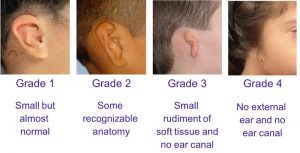Menu

Microtia is a rare birth defect that affects only 1 to 5 out of every 10,000 babies in the world annually. Families who have children suffering from microtia may understandably feel a sense of panic as the condition compromises the victim’s hearing, but it isn’t short on surgical solutions. With that in mind, we’re here to shed some light on microtia and atresia to help you manage down the line.
What are Microtia and Atresia?
By the 28th week of a mother’s pregnancy, the baby’s ears are typically done developing and should be complete. Within the timeframe, there are rare occurrences wherein one or both ears fail to form properly. Physically, it will look that part of the ear is missing, which refers to a congenital deformity called microtia. There are four grades of this unusual ear malformation:
- Grade 1 – it manifests as a smaller version of a standard ear, accompanied by a smaller ear canal
- Grade 2 – this refers to the partial formation of an ear with a narrow ear canal
- Grade 3 – the absence of an external ear, with only the appearance of a peanut-shaped structure due to the cartilage and earlobe. There is no ear canal or eardrum.
- Grade 4 – a complete absence of the entire ear, which is also known as anotia.

Atresia often follows suit, which points to the absence of the external auditory ear canal. This condition will compromise the middle ear bones, such as the incus, stapes, and malleus, which results in moderate-to-severe conductive hearing loss and vulnerability to ear infections. Fortunately, there are various ways to repair the rare condition.
Treatment Options for Microtia
Modern technology has now opened new ways to improve medical surgeries, part of which are the following:
- Rib Graft Construction – this procedure refers to creating an ear sculpture using the patient’s own rib cartilage. This is one of the best methods as rib cartilage is durable, meanwhile, the body has higher chances of accepting the new tissues in the ear as it comes from the child’s own body rather than a third-party, implant material. Keep in mind that this is recommended for children ages 8 to 10 years-old as the procedure can span over a few months to a year.
- Medpor Graft Surgery – this surgery involves utilizing a synthetic material rather than rib cartilage to implant inside the child’s ear. It is a less invasive and painful procedure, which is why children as young as 3-years-old can safely proceed with the surgery. While the results are more consistent, the drawback is that the body may reject the implant as it does not easily incorporate into the surrounding tissue, which can potentially lead to infections.
Meanwhile, surgeons will also need to widen or create an ear canal for children struggling with anotia. To that end, the two options above are the most invasive treatment plans, but there is an alternative for parents who prefer not to go for reconstructive surgery. Children may improve their hearing by utilizing a prosthetic ear instead, which doctors can secure using magnets or an adhesive.
If your child has microtia, understanding what to expect and exploring treatment options will help you decide the best course of action to take. Of course, part of this plan should involve seeking medical help from an ENT specialist and pediatric audiologists. They have the necessary expertise, training, education, and equipment to examine your child’s hearing and come up with the best solution to improve your child’s hearing.
If you are looking for an audiologist in Langley, BC to help you or your loved one with microtia or atresia, get in touch with us to see how we can help.
Share Post
Facebook
Twitter
LinkedIn
Email
Reddit
Pinterest
